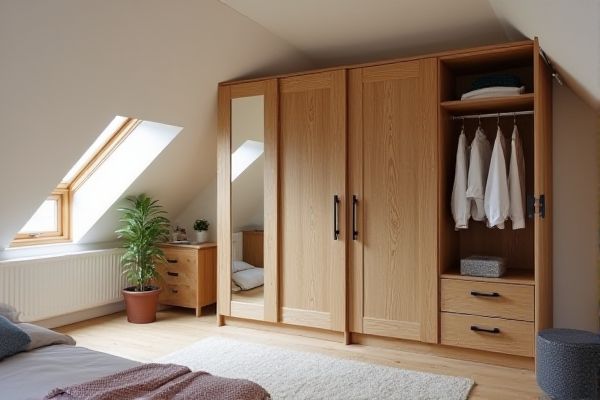
Choosing between an attic closet and a freestanding wardrobe depends on your space constraints and storage needs, as attic closets make efficient use of awkward under-eave areas while freestanding wardrobes offer flexibility and portability. Explore this article to discover which solution best suits your home and personal style.
Table of Comparison
| Feature | Attic Closet | Freestanding Wardrobe |
|---|---|---|
| Installation | Built-in, customized to attic space | Movable, no installation required |
| Space Utilization | Maximizes sloped ceilings and awkward corners | Requires flat wall space |
| Storage Capacity | Highly customizable, fits entire attic section | Limited to wardrobe size |
| Cost | Higher upfront due to custom build | Generally more affordable |
| Aesthetics | Seamless integration with attic design | Varies by style and brand |
| Mobility | Fixed installation, not movable | Portable and easy to relocate |
| Durability | Long-lasting with quality materials | Dependent on build quality and materials |
| Customization | Highly customizable to fit unique attic shapes | Limited customization options |
Introduction: Attic Closet vs Freestanding Wardrobe
An attic closet maximizes the use of sloped ceiling spaces with custom-built storage solutions tailored to irregular dimensions, offering seamless integration and optimized capacity. Freestanding wardrobes provide versatile and movable storage options that suit various room layouts without permanent installation. Your choice depends on space constraints and the need for customization versus flexibility.
Space Optimization in Attic Closets
Attic closets are designed to maximize space utilization by fitting custom storage solutions into the unique angles and low ceilings of attic spaces, unlike freestanding wardrobes that require flat wall areas. These built-in closets often include tailored compartments, shelves, and hanging rods that adapt to sloped ceilings, making the most of awkward or unused spaces. Optimizing your attic closet can significantly enhance storage capacity while maintaining a clean and organized room layout.
Flexibility and Mobility of Freestanding Wardrobes
Freestanding wardrobes offer superior flexibility and mobility compared to attic closets, as they can be easily relocated or rearranged to suit changing room layouts and storage needs. Unlike fixed attic closets that require permanent installation and modifications, freestanding wardrobes provide customizable options in size, style, and interior configuration without structural alterations. Their portability makes them ideal for renters or individuals seeking adaptable storage solutions in dynamic living spaces.
Design and Style Options Comparison
Attic closets offer custom-built design solutions that maximize irregular spaces with tailored shelving and integrated storage, blending seamlessly into your home's architecture. Freestanding wardrobes provide versatile style options, ranging from classic wooden finishes to modern minimalist designs, allowing you to easily change or relocate your storage piece. Your choice depends on whether you prefer a personalized, space-efficient setup or a flexible, movable wardrobe that suits evolving decor trends.
Storage Capacity and Organization
Attic closets maximize storage capacity by utilizing built-in space, often customized to fit awkward angles and maximize every inch, making them ideal for storing seasonal items or bulky belongings. Freestanding wardrobes offer flexible organization with adjustable shelves, drawers, and hanging rods, allowing you to tailor the interior to your clothing and accessory needs. Your choice depends on whether you prioritize permanent, space-saving storage or adaptable, movable options for easy reorganization.
Installation and Customization Considerations
Attic closets require precise measurements and often professional installation due to sloped ceilings and limited space, allowing for highly customized storage solutions that maximize every inch. Freestanding wardrobes offer easier setup and mobility but may lack the tailored fit and efficient use of space that attic closets provide. Your choice should balance the complexity of installation with the need for personalized storage options to optimize functionality.
Cost Analysis: Attic Closet vs Freestanding Wardrobe
An attic closet typically requires a higher upfront investment due to custom fitting and potential structural modifications, while a freestanding wardrobe offers a more budget-friendly and flexible option. Your overall cost for an attic closet may include labor and materials, whereas a freestanding wardrobe primarily involves purchasing price and possible delivery fees. Long-term, attic closets can increase home value, making them a worthwhile investment despite the initial expense.
Durability and Maintenance Requirements
Attic closets are typically built-in structures that offer superior durability due to their integration with the home's framework and use of high-quality, fixed materials. Maintenance for attic closets generally involves periodic inspection for moisture or pests, as their enclosed space can be more susceptible to environmental factors. Freestanding wardrobes, while versatile and easier to move, often require more frequent upkeep such as tightening joints and refinishing surfaces to address wear and tear from regular use.
Suitability for Different Home Layouts
Attic closets are ideal for homes with sloped ceilings or limited floor space, maximizing storage by fitting into awkward nooks and under eaves. Freestanding wardrobes offer versatility for open-room layouts, allowing easy relocation and flexibility in placement. Choosing between the two depends on spatial constraints and the need for customizable storage solutions in varying home designs.
Which Storage Solution Is Best for You?
Choosing between an attic closet and a freestanding wardrobe depends on your available space and storage needs. An attic closet maximizes under-roof areas, providing customized compartments ideal for seasonal items, while a freestanding wardrobe offers flexibility and mobility for varied room layouts. Consider your room size, accessibility, and organizational preferences to determine which storage solution best suits your lifestyle.
 homyna.com
homyna.com